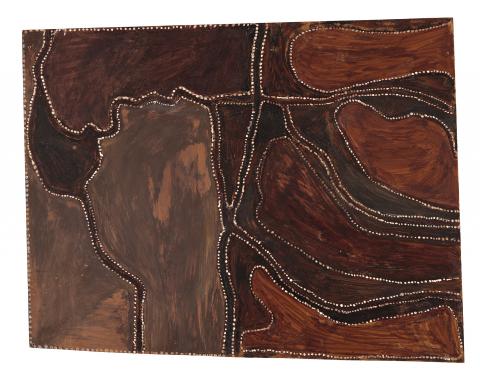UNTITLED (MAP OF TURKEY CREEK AND SURROUNDS), c.1984
ROVER THOMAS (JOOLAMA)
natural earth pigments and natural binders on composition board
97.0 x 122.0 cm
Painted at Warmun, Turkey Creek (displayed at the Turkey Creek Roadhouse until 1987)
Collection of the late Duncan Kentish, Adelaide, acquired directly from the artist in 1987
Bedford Downs, 1984, in the Holmes à Court Collection, illus. in Carrigan, B., Rover Thomas: I Want to Paint, Holmes à Court Gallery, Perth, 2003, cat. 9
Ngamarrin (The Snake near Turkey Creek Country), 1984, in the collection of the National Gallery of Australia, illus. in Thomas, R., et al, Roads Cross: The Paintings of Rover Thomas, National Gallery of Australia, Canberra, 1994, p.38
Pilpirrji (Argyle Hill), 1984, in the collection of the National Gallery, illus. in Thomas, R., et al, Roads Cross: The Paintings of Rover Thomas, National Gallery of Australia, Canberra, 1994, p.18
Untitled, 1984, in the collection of the Berndt Museum illus. in Stanton, J. E., Painting the Country: Contemporary Aboriginal Art from the Kimberley Region, Western Australia, The University of Western Australia Press, Nedlands, 1989, p. 38, pl. 34
Untitled (Map of Turkey Creek and Surrounds) is likely to have been painted in 1984, early in Rover Thomas’ public painting career. In that year, he created a number of works that render the east Kimberley landscape in a planar, map-like perspective, with the elements of each work referring to sites of ancestral or historical significance, and pathways travelled by both the creator beings and the artist himself in his days as a drover on cattle stations in the region. Among these are three other paintings on board: Bedford Downs, 1984 (Holmes à Court Collection, Perth) which depicts the site of a massacre of Aboriginal people in the early 1920s. Ngamarrin (The Snake near Turkey Creek Country), 1984 (National Gallery of Australia) which features Wungurr, the Rainbow Serpent who in the form of Cyclone Tracy destroyed the city of Darwin in 1974, approaching the township of Turkey Creek (Warmun); and Pilpirrji (Argyle Hill), 1984 (National Gallery of Australia) which illustrates a hill submerged by the flooding of the Ord River basin to create Lake Argyle in the 1960s. A large untitled canvas painted in the same year in the collection of the Berndt Museum follows the same theme, depicting Rover Thomas’ country of origin at Kunawarritji (near Well 33 on the Canning Stock Route), from the perspective of Warmun where he went to live in early 1975.
In this orientation, the direction of north lies towards the lower edge of the painting. In a probable reading of the image, the dark brown form in the top left of the painting represents Lake Argyle into which the Ord River flows, and its tributary, the Bow River appears as a meander to the right, flowing through Lissadell Station towards the Great Northern Highway, the vertical line that bisects the painting vertically.
WALLY CARUANA
